#revolutionary iconography
Text
Fragile.

#frev#french revolution#frev art#robespierre#maximilien robespierre#thermidor#art#traditional art#my art#revolutionary iconography
68 notes
·
View notes
Text
A recent staple of activist iconography, the #Anonymous mask actually has its roots in the 17th century plot by Guy Fawkes to blow up London’s Houses of Parliament.
20 notes
·
View notes
Text
we need plentiful feminist street art because readily accessible iconography and arresting visuals are essential to the sense of well-being of the revolutionary woman
479 notes
·
View notes
Text
I also made this post on the BRC subreddit but unsure if it'll stay up there so I figured I'd also share here on the off chance it gets taken. Just had thoughts about the visual symbolism with Faux and Felix that I needed to get out of my system.
Spoilers ahead for Chapter 5 and BRC endgame!
When I was going into the final boss fight, my best friend had wanted to be on voice call because there was a particular shot after the fight that she really wanted me to see: the one where Solace became Felix's "one wing".
Considering Felix going solo catalyzed the contention between him and Faux, the way Felix's "I only need one wing" mentality evolved between his first All City to the end of BRC's narrative is one of the things that really struck me with this shot. Felix's one wing was initially something borne from his decision to break away from the Big 3 in order to go solo — relying on his own merits in order to reach the pinnacle of the streets. It's never explicitly said if he really thought of Faux as a burden ("Felix... you never wanted us to be a crew and why would you? You gained so much from dropping me.") but from Felix's perspective, there were "no hard feelings" which implies that there was no actual resentment on his side. DJ also certainly didn't seem to really care either way. But ultimately the choice to be on his own with his one wing is the thing that led to his death, since Faux took it hard enough that he... y'know...
But with this?
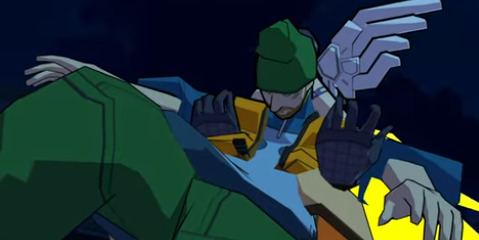
[ID: Felix with one of Solace's wings showing up behind him]
Sure, it's just Solace. But Solace represents more than just himself — Solace represents BRC, all of them. The entire narrative follows Felix as Red, back at the bottom of the rung with Tryce and Bel, as the three of them work to the top. As Red, he still had inclinations towards handling his whole "retrieving his head and finding out his roots" situation on his own. But it was through Tryce and Bel's insistence that they stick together and their constant support and care that overcomes those inclinations. As Red, he intentionally chose and was able to reach the pinnacle with other people, with a crew — something that old Felix thought wasn't possible even when Faux, one of the best of his contemporaries, had offered it.
I think about this shot a lot ever since I saw it in-game. But then I came across another one as I was watching another person's playthrough with the same friend:

[ID: Faux's introduction in Chapter 1 at the New Amsterdam Police Bureau, with the outer ring of the Police Bureau's logo prominent behind his head]
The above shot caught me so off guard because it truly is a "blink and you miss it" kind of moment since Faux zooms in from this particular shot pretty quickly. But the New Amsterdam Police Bureau logo makes a flipping halo behind him. Along with the alias, this could potentially be its own foreshadowing to Faux's real nature: that he's not who he seems to be, that he's your foe, but that he's also deified himself in his own head and eventually deified through Project Algo where he assumes control of the police force.
(And since Solace is sometimes called by other characters as an "angel boy" or Felix's "angel fan", you can potentially get some lovely interpretations stemming from religious iconography, but that's something for another day if not coming from another person entirely.)
Am I reading too much into this? Most definitely. But while the actual plot of BRC isn't revolutionary, a lot of the things that make it enjoyable for me is filling it in with things like this in order to enrich the world and the story more. So I figured I'd also share the joy that came with these random thoughts with others — and if you've made it to the end, thanks for reading!
33 notes
·
View notes
Note
So, about flags, not sure if this is a hot take: but don't you think the red background, yellow stars, maybe hammer&sickle design a lot of socialist states had (or have) is overused and bad? Like flags represent countries, so if all the flag represents is its economic system that seems like a little too empty of a flag imo. It's kinda like if the US had a yellow background and a bank for a flag. The USSR is kinda exempt since they were the first, but then everyone decided to copy their homework.
i mean i do think that a socialist revolution should by any meaningful sense of the world establish an entirely new state, it represents a little bit more than just 'an economic system'--but i do generally agree, i think that adaptations of recognizable communist iconography to the specific revolutionary conditions of the country are better than just straightforwardly copying the hammer and sickle. cf. the wpk, gdr, and mozambique:
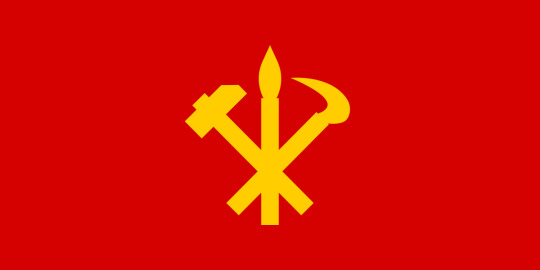


70 notes
·
View notes
Photo
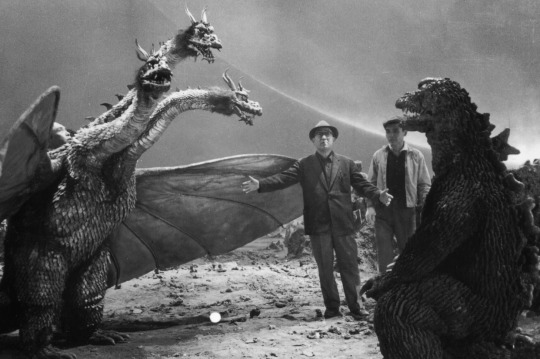

Tsuburaya Eiji, the Father of Tokusatsu
Eiji Tsuburaya made it possible for Godzilla to stomp across the screen and later on, Ultraman. A director, cinematographer, and producer, Tsuburaya is best known for creating the special effects behind Japanese classics like Godzilla and other giant monsters called kaiju.
And his legacy extends beyond those monsters — he built a foundation for film culture in Japan and special effects worldwide.
Before World War II

Tsuburaya grew up in Sukagawa, Iwase, a son of a prominent family of grocery distributors. A prodigy from a young age, as a kid he was interviewed about his model airplanes and credited in local newspapers as a "child craftsman." Shortly thereafter, he was captivated by a new technology called motion pictures — and he combined his two passions by taking pictures of planes.
But it was 1933's King Kong that led to his greatest professional epiphany. King Kong's giant title character and phenomenal special effects opened up a new world of possibilities for Tsuburaya. By studying a copy of the film, Tsuburaya managed to reverse engineer how the effects were made. Then he was ready to begin creating his own legacy.
Being a film revolutionary wasn't easy with his early battles over budget and setup, but when a new company called Toho Motion Picture Company was founded in 1936, Tsuburaya jumped on board to lead the special effects department.
After World War II
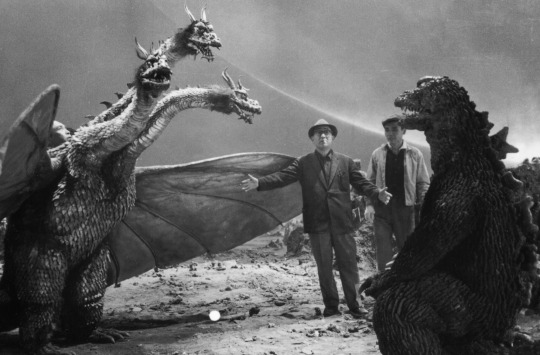
After being drafted to work on propaganda films in World War II and experiencing the napalm bombing of Tokyo, he returned to work at Toho after the end of US occupation in 1952, keeping a low profile because the US believed he'd committed espionage.
It was in that climate that producer Tomoyuki Tanaka was artistically inspired by the fallout of a US hydrogen bomb test in the Marshall Islands. The real story of a radiation-poisoned fishing crew inspired him to pitch a monster movie to Tsuburaya and Toho. After some creative wrangling, Godzilla was born.
For Godzilla, Tsuburaya made the bold choice to use miniatures and visual effects instead of stop-motion animation, which was a more obvious alternative. The idea to put an actor in a monster costume was going to be executed as never before, and with it a legendary monster was born.
Though Godzilla was the product of a large team, it came alive because of Tsuburaya's use of models, special photography, and inimitable costumes.

Godzilla was a tough shoot. Actors were stuffed into a costume that was, at its lightest, 220 pounds. They breathed in kerosene from the fumes of a tiny "Tokyo" model burning beneath them, and actor Haruo Nakajima says he lost 20 pounds in the production because the costume was so physically strenuous.
The film was a financial risk, as well — it became the most expensive Japanese movie made up to that time. But Godzilla was a hit, and it kicked off "monster mania." Film by film, these movies created a kaiju iconography that shaped an entire film industry's sensibility — and built a legacy for Tsuburaya.
Tsuburaya's professional and creative successes continued through the 1960s, as he innovated with more intricate models and formed his own company, Tsuburaya Visual Effects Productions, in 1963 where he created what kaiju superfans consider his landmark work, like Ultra Q and Ultraman in 1966.
Today

Though Tsuburaya died in 1970, his creations remain embedded in the culture today. Even to those who aren't fans of Tsuburaya's distinctive style, his aesthetic, effects, and ethos permeate movies today.
There are obvious influences, like the many Godzilla remakes and the kaiju fan letter that is 2013's Pacific Rim. Without Godzilla, there is no Ultraman. And without Ultraman, there is no Super Sentai (Power Rangers) and so on.
Tsuburaya's influence can also be seen in every disaster movie's audacious carnage and ever-more-adventurous willingness to push boundaries using special effects.
That's probably why we still thrill to learn about the man who made all those monster suits really roar. Because even now, more than 50 years later, it's as exciting, outrageous, and thrilling as when Godzilla first hit the screen.
Thank You Tsuburaya Eiji for making our childhood a memorable one and our adulthood an awesome one!
Pics by Ultraman NFT & Vox
Full Story : Eiji Tsuburaya made Godzilla and it changed film forever
Follow Ultraman NFT & August Ragone if you’re a Tokusatsu fan!
#tsuburaya eiji#eiji tsuburaya#tsuburaya productions#godzilla#king kong#ultraman#ultra q#kaiju#japan#tokusatsu#japanese film#japanese movie#japanese drama#pacific rim#super sentai#power rangers#ultra series
103 notes
·
View notes
Text
Yet the legacy of Las Soldaderas has been almost entirely redefined and retold through a primarily male perspective. It was even happening during the Revolution: Men would write songs about Las Soldaderas, emphasizing their femininity and overt sexuality, in order to diminish their military contributions and accomplishments, according to Fernández’s research. Their image was structured around these male-written corridos. Iconography surrounding Las Soldaderas often featured women dressed in low-cut, skin-tight outfits with ammunition-filled bandolier slung over their chests a la Cruz and Hayak’s Hollywood depictions. These depictions of Las Soldaderas would come to be known as Las Adelitas, named after the famed ballad La Adelita, which described an unknown soldadera who was as pretty as she was brave. Soon, the scandalous depictions of Las Adelitas would become synonymous with the worldwide image of Las Soldaderas.
But Las Soldaderas weren’t fighting for their country in brassieres — they were women often dressed like their male counterparts, in battle-ready trousers and long-sleeved shirts, with bullets strapped across their chest and guns holstered around their waists, although some did wear floor-length skirts. Under the leadership of Petra Herrera, perhaps the most well-known soldadera, a brigade of nearly 400 women aided revolutionary leader Pancho Villa, who wasn’t particularly fond of female soldiers, in his effort to take the city of Torreón from the federales. Others acted as spies across the country, nursed the wounded on both sides of the war, and even used their gender to escape from prison.
“It was hard for people to reconcile: ‘How do we remember these courageous women who were fighting in this war, but we also still continue to treat them badly?’ And one way to negate their contributions is to say, ‘Oh, these sex objects were there as well. These people are very nice to look at, and if you put a gun on them it makes them sexy and dangerous at the same time,’” Fernández says. “[This] really negates the ideas of the toughness, the mestizo toughness, the physical toughness that the women brought with them and their contributions.”
20 notes
·
View notes
Text
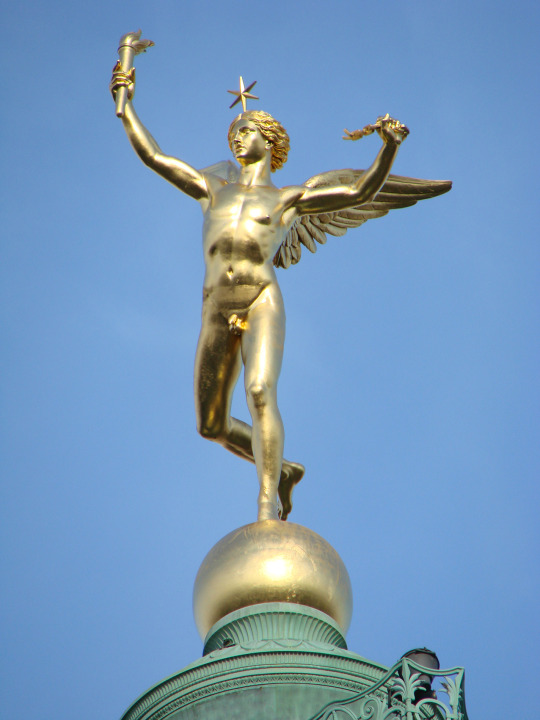
This connection between Satan and revolution is probably nowhere more eloquently illustrated than on the Place de La Bastille in Paris, where the French revolutionary elan is honored by an immense brass column that was erected after the July Revolution of 1830. It is topped by a gilded statue four meters high that was designed by Auguste Dumont and is officially called the "Genie de la Liberte." Anyone familiar with the nineteenth-century iconography of Satan, however, immediately will recognize yet another avatar of Lucifer, the angel of light and liberty, in this figure of a nude winged youth with a star shining above his head and a flaming torch in his hand.
- Ruben van Luijk in Children of Lucifer: The Origins of Modern Religious Satanism
#czortposting#lucifer#luciferian#romantic satanism#luciferianism#satanic#theistic luciferian#satan#statue#paris#lucifer art#spirit art
164 notes
·
View notes
Text
Three Clerks
Last week I tweaked my back. It hurt. A lot. As I recovered, I found that sketching with pen and pencil was less strenuous than writing on keyboard. So that's what I did.
Sketched characters from an adventure I am currently writing for Colin Le Sueur's We Deal In Lead. It began as a homage to Wisit Sasanatieng's tomyamgong western Fa Thalai Chon / Tears Of The Black Tiger.
+++

SHIN SUL SHAP, SHRINE CLERK
4 Grit 10 STR 10 DEX 10 HRT
Switch (d4)
Face hidden by a broad-brimmed bonnet and veil. Patrols the lines of pilgrims; like a schoolmarm she thwacks anybody chit-chatting. Piety should be silent!
A waif snatches a lead token from her pouch, and bolts. A chase ensues. He begs your help. If Sul Shap finds him, she will sell him to captive takers.
+
Sul Shap is a clerk at the Shrine To The Headless Sun: a bare plaza; a marble pavilion; a golden man, with an ever-burning flame where his head should be.
The Headless Sun is patron saint of the Admiralty, whose laws now govern both Ocean and Sea. He was its founder. The kings of old captured and beheaded him. He overthrew them anyway.
+++
References for Sul Shap were basically Buddhist nun robes (mainly for the volume of fabric), plus an European bonnet.
Initially I'd imagined a conventional broad-brim hat---ie: her veil would be a cylinder around her whole head. But as I sketched I thought the bonnet made a more interesting shape? Also its rear was an opportunity to create a crest / halo of sun-rays. Religious iconography!
Alms bowl, because giving is a virtue. But the Headless Sun values ego-death, not asceticism---so colourful beads and gold amulets and pouches full of lead tokens (money).
+++

RIS SHAY NAM, RECORDS CLERK
2 Grit 10 STR 10 DEX 10 HRT
Swung typewriter (d4)
In a wheelbarrow, pulled by a servitor, typewriter balanced on her belly, pockets filled with banana fritters. Greasy fingerprints on any document she works on.
Shay Nam thinks herself a moral soul. Will side with abolitionists and revolutionaries, with justice—until her own skin is at risk.
+
Shay Nam works at the Hibiscus Court. Princess Khur San, distancing herself from the old order, surrendered this palace to bureaucrats.
Clerks have filled its once-airy halls with shelves. By sympathetic sorcery, all contracts in the province manifest copies here. Rumour has it that this magic works both ways.
+++
This was my first sketch. In pain and bored I just started drawing.
No references, and it shows? Skirt and stockings and boots because these were the easiest for me to do. In my mind Shay Nam was an archetypal overweight NEET. Here she looks to be a sassy layabout. I like her better, now!
Also: a servitor is an empty body. Created when you ritually touch a shrine-stone to the Headless Sun---your soul is obliterated. What is left behind is mindless, hence the harness and reins.
+++
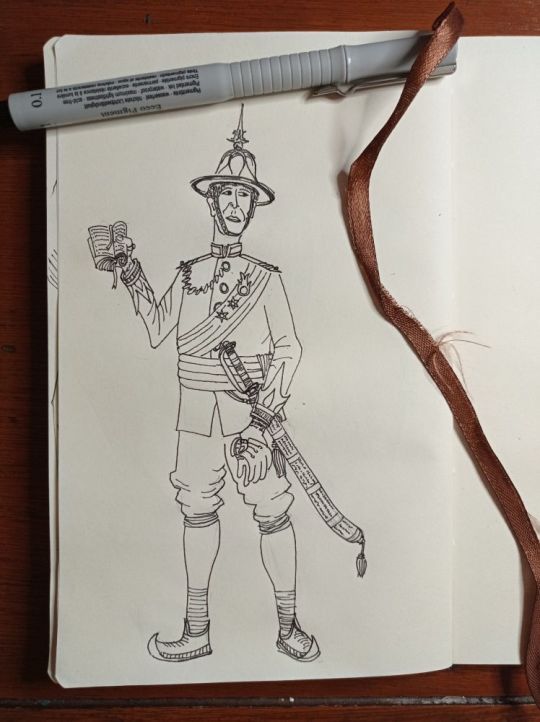
KHAN YUL MIN, COURT CLERK
4 Grit 1 DEF 10 STR 10 DEX 10 HRT
Sabre (d8)
A university grad and former marine. But his townhouse sits below Rose Hill, on Merchant’s Row, beneath the old families' notice.
Yul Min means to change this. He has his eye on the Widow Gon. He will hire ruffians to waylay her palanquin—then swoop in, to rescue her. Elaborate theatre.
+++
Yul Min, like all these characters, live on the Sea of Sorrows, whose waters are literally the souls of the dead.
Roses always bleach within sight of it; to retain their colour they must be shipped in glass, then kept in arboreta—never once sharing air with the Sea.
Those who can afford red-rose gardens tend them on the south end of the city, where streets begin to climb Mount Go, in compounds walled like fortresses.
+++
Drew Yul Min last night. Had tabs open for "Thai traditional clothing" & "military uniforms 18th century" & "krabi" & "Vajiralongkorn".
Given my inspiration, I think the referencing of Mainland Southeast Asian material culture is appropriate. Maybe a little to obvious, though? Ie: the visual forms haven't been composted well, into new and more imaginative shapes ...
Still: very pleased with the proportions and details.
I liked how the hamsa-esque icon of the Headless Sun developed over the course of these sketches. I would not have discovered it, otherwise; it's one of those details, too small for words.
Drawing is an intrinsic part of the writing process, I guess!
+++
#writing#art#illustration#sea of sorrows#ttrpgs#characters#clerks#process notes#we deal in lead#fantasies#adventures#settings
13 notes
·
View notes
Text
#1 - Galaxian (1979) (Yes, Actually)

What the? You said you'd be playing all the Pacs! But that's clearly Galaxian! What gives?! Well, if you'll just sit down, you'll understand a bit...
So... Technicality is a funny thing. One moment you're sitting down to play every single Pac-Man game you can think of in chronological order, and the next thing you know, you're playing a game before Pac-Man chronologically released. Such is the power of highly-specific iconography that would later come to be heavily associated with the series actually appearing in a game before it even existed!
So. Galaxian. You've probably heard of it if you've heard of video games before--or at the very least, you've heard of its older brother, Galaga. While the latter doesn't meet the requirements to be a Pac (and quite frankly, this game almost didn't), there's juuust enough here that makes us raise an eyebrow and say, "this'll do."
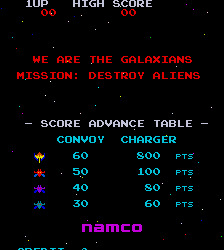
What's this? Why, at the top of the "Score Advance Table" is none other than... The word "Convoy"! And below that and to the left is none other than the Galaxian Flagship. On the off-chance you've never gotten far enough in Pac-Man before, or just never used his Neutral B in Smash, that there alien flagship was effectively Namco's de-facto mascot before Pac-Man really shook things up for them. As a result, it got a cameo in the first Pac-Man game and has been closely orbiting Pac-Man ever since!
Also, wait, the Galaxians are the heroes and we're just fighting aliens? That's definitely strange, seeing as in Galaga the enemies are manned by the "Boss Galaga", which seems to imply the alternative.

Though, not as strange as the fact your ship is also called a... Galaxip. Just rolls off the tongue there.

Okay, one thing that's not apparent in these still images is that this game is shrill. Like, very high-pitched and very squeaky. Especially compared to many other early Arcade games, it sticks out like a sore thumb in just how dang loud this game is. Anyways, the standard game loop of Galaxian aren't really anything to write home about--and they weren't even when the game first released. Space Invaders had already existed for some time, after all.
No, Galaxian stood out for a few other reasons. For one, as that cyan alien is kindly demonstrating, the aliens don't just sit there and take your fire, only occasionally firing back. No, when an alien wants to fire back, it descends from formation to both shoot at you and also try and take a swing at you--contact damage will kill you! Secondly, and why those Flagships are so important and why this game was as revolutionary as it was...

Yep, the enemies actively employ the buddy system. Flagships will bring up to 2 Red Aliens with them at a time, descending upon you with not only increased firepower, but the red aliens will actually serve as a meat(? spacecraft?) shield for the Flagship, tanking shots themselves to prevent you from getting a solid shot in.

They do a good job, evidently, because wow we stink at Galaxian. We'd like to think we're okay enough at video games--we've got a few challenge runs of games much more complex than this under our belt--but it just goes to show that sometimes the simplest things to grasp can totally kick you in the shins.

In addition, however, there's one last detail; should there only be a few aliens left standing, they'll enter a sort of panic mode and, instead of returning to their spot in formation, they will gladly charge you endlessly. Forever, if necessary! Until either you shoot them down or they take you out, they will endlessly circle from the top to the bottom, wrapping back around and occasionally firing at you.

So, let's say you brave the trials that the Flagship ship poises, and properly gun it down in spite of its bodyguards. The game's actually equipped to handle various possibilities and reward you accordingly for how "dangerous" the game deemed it. The factors--as far as we could tell--are if the Flagship died last, and how many Red Aliens guarding it you took out. Pictured is the result of gunning down the maximum two red aliens guarding a Flagship, before gunning the Flagship itself down. This resulted in 800 points, the maximum amount you can get out of a Flagship! It's worth mentioning you only have one bullet per round, so your aim needs to be pretty good to get this. One miss and that thing will gladly rocket to the other end of the screen, leaving you a sitting duck while the aliens get to circle back unscathed.

You may be wondering if anything unique happens if you clear the board of all aliens. Does the game end? Are the Galaxians safe from the intergalactic conflict they've found themselves in? Do the aliens do a little dance?

Nope, the round simply resets and a new set of aliens shows up. You actually get a little indicator of how many rounds you've cleared in the bottom right, however--looking it up, the game will actually abbreviate the flags if you clear 10 rounds of this. Can you imagine 10 rounds of pure, unaltered Galaxian? Too much for us, at least.

Still, this was a fun time, and we're glad we got to sit down and warm up to this project with this game. Get our proverbial feet wet, and all that. But let's be real here--you didn't come here for the Flagship. You're here for a different guy entirely.
Never you mind, we getcha, and we hear ya loud and clear. And no fake-outs next time; we're playin' the original Pac-Man. See ya whenever we get around to that one!
#all the pacs#pac man#pacman#1979#galaxian#one of our favorite bits is when a series of games technically starts with a game seemingly unrelated#like how in raocow's ill-fated all the sonics it turned out Flicky was the first game to meet his definitions#or how every mario game technically ties directly back to Donkey Kong. a game not named after mario at all#we hope we did this bit justice
7 notes
·
View notes
Text
Fuck it. Let's steal more shit from Cuno's dad.

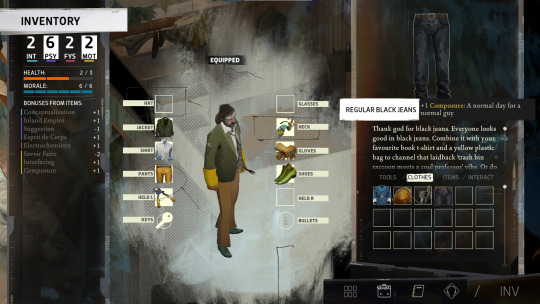
REGULAR BLACK JEANS
+1 Composure: A normal day for a normal guy
Thank god for black jeans. Everyone looks good in black jeans. Combine it with your favourite book t-shirt and a yellow plastic bag to channel that laidback 'trashbin raccoon meets a cool professor' vibe. Or do whatever you want -- it's just a pair of black jeans after all.
Finally, some good clothes. I equip these.
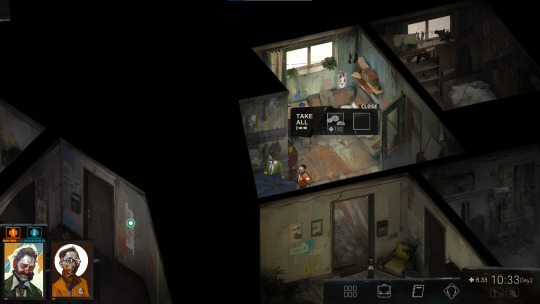
I also take 1.10 real.

Here there's a door that leads to the Smoker's balcony.
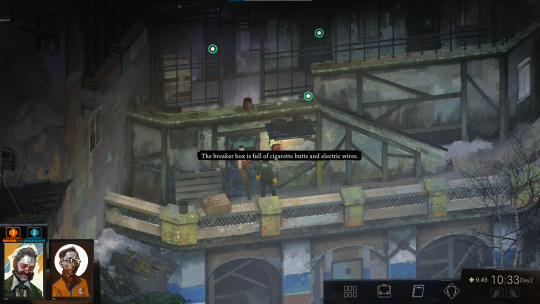
The breaker box is full of cigarette butts and electric wires.
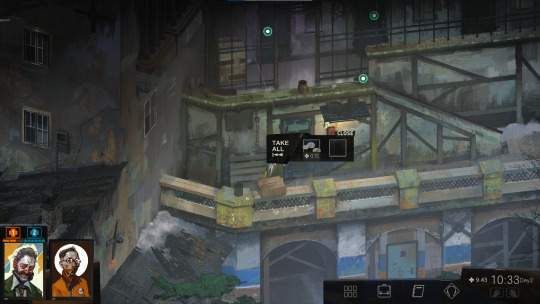
0.15 real...
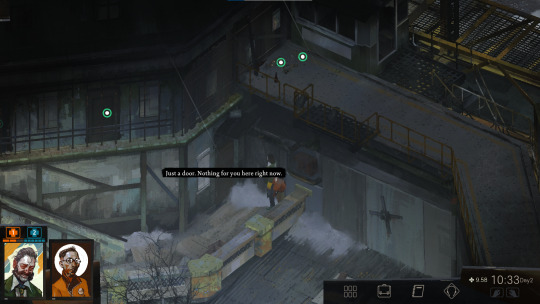
Just a door. Nothing for you here right now.
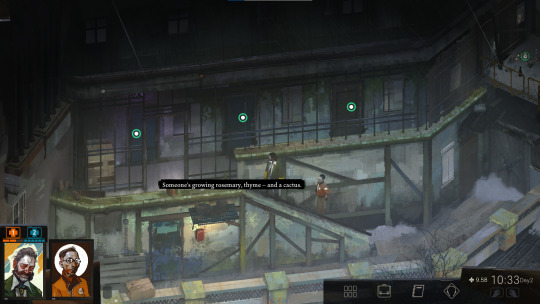
Someone's growing rosemary, thyme -- and a cactus.
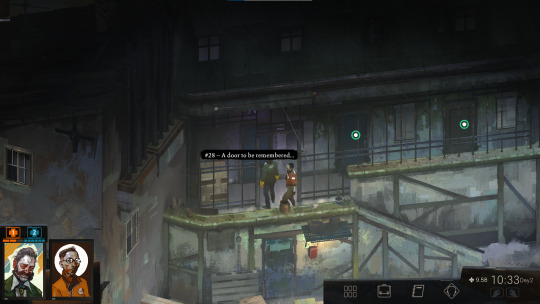
#28 -- A door to be remembered.
This is the door to apartment #29.
This is the door to apartment #30.
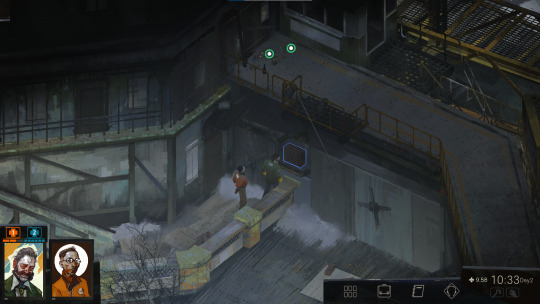
Equipping the prybar allows us to open this box. There's 0.75 real inside.
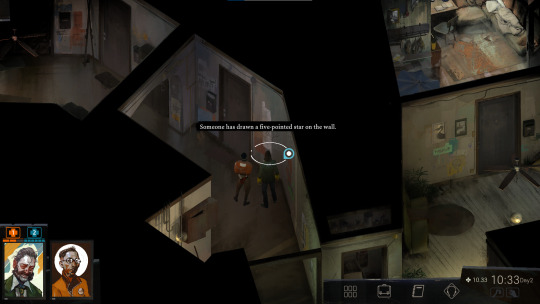
Someone has drawn a five-pointed star on the wall.
ENCYCLOPEDIA - That isn't *just* a five-pointed star -- it's an inverted white pentagram cradled in a wreath of antlers. The iconography of communism, in other words.
Inspect the symbol closer.
[Disregard thought.]
ENCYCLOPEDIA - The star-and-antlers was developed in the sixth decade of the last century and quickly adopted by Mazov and the communards during the Revolution...
Even today, half a century after, the star-and-antlers retains the ability to evoke hope, disappointment, and fear in equal measure.
Why is the star upside down?
What's the deal with the antlers?
Why white?
What does it evoke in me?
[Finish thought.]
ENCYCLOPEDIA - To symbolize the toppling of the old order.
Also, some social democrats were already using it.
2. What's the deal with the antlers?
ENCYCLOPEDIA - The wreath of antlers represents a natural crown. It was about building a society that could exist in accord with the natural world -- and at the same time above it.
3. Why white?
ENCYCLOPEDIA - Because white is the colour of peace.
4. What does it evoke in me? [Finish thought.]
ENCYCLOPEDIA - Gone. Gone is the glory. Of hope, only the scribblings of impoverished students remain. In dirty hallways...
-1 Morale

PADLOCKED DOOR - This door has been closed with a padlock. A chalk-drawn number on the board says #11.
Knock.
Examine the padlock.
[Leave.]
PADLOCKED DOOR - No reply.
2. Examine the padlock.
PADLOCKED DOOR - It's a solid lump of metal, but the shackle is deeply corroded -- a solid pair of chaincutters would make short work of it.
INTERFACING [Easy: Success] - Better whip out those cutters... you won't get very far otherwise.
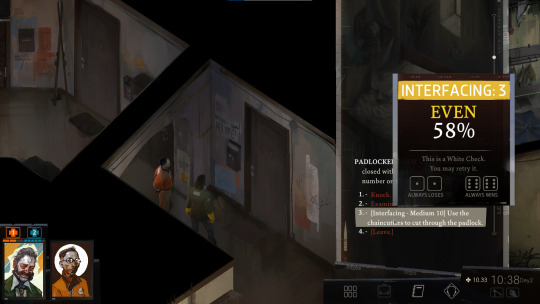
3. [Interfacing - Medium 10] Use the chaincutters to cut through the padlock.
May as well keep breaking into apartments. One of these has to belong to the smoker. (Also, I'm pretty sure this is the only way to get access to this one.)
INTERFACING [Medium: Failure] - What are you doing? You're trying to cut the body of the lock with the chaincutters and it's really not working.

KIM KITSURAGI - "I believe it's the *shackle* you mean to cut, detective." The lieutenant points to the corroded loop with a gloved finger.
-1 Morale
EMPATHY [Medium: Success] - He's just trying to help, don't take it... bad. Relax.
"Don't you think that's what I'm *trying* to do?"
"These chaincutters are broken, Kim."
KIM KITSURAGI - "Perhaps you should give it another go?"

+1 Kim pointed out the shackle.

INTERFACING [Medium: Success] - The shackle snaps like a twig and the lock falls to the floor with a little thud. It should be possible to enter now...
KIM KITSURAGI - "After you, detective."
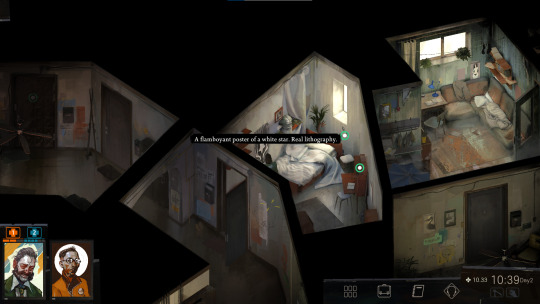
A flamboyant poster of a white star. Real lithography.
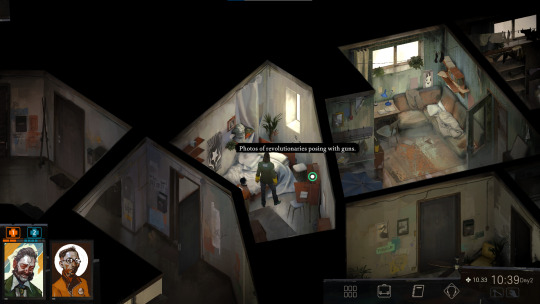
Photos of revolutionaries posing with guns.
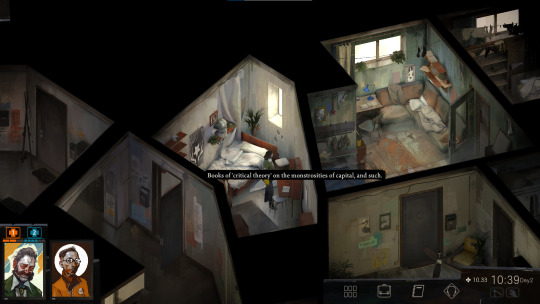
Books of 'critical theory' on the monstrosities of capital, and such.
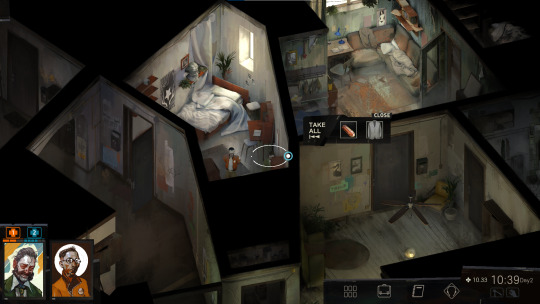
Revolutionaries *love* to pose with their guns.
In the chest is a jacket and a single bullet.
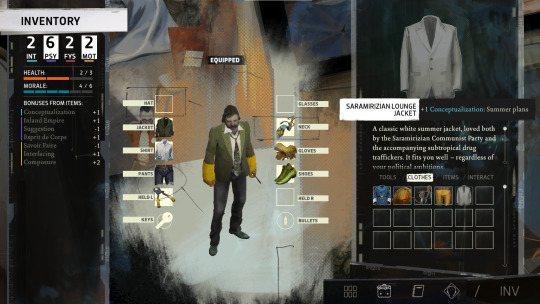
SAZAMIRIZIAN LOUNGE JACKET
+1 Conceptualization: Summer plans
A classic white summer jacket, loved both by the Sazamirizian Commission Party and the accompanying subtropical drug traffickers. it fits you well -- regardless of your political ambitions.
This'll look great with our black jeans. Also, it gives us a useful stat bonus.
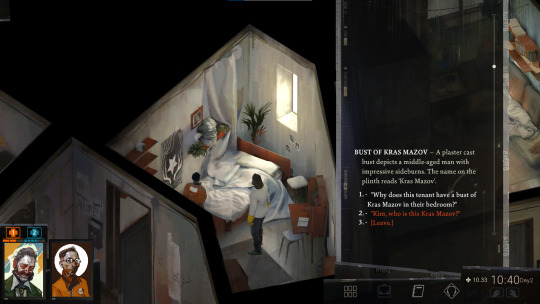
BUST OF KRAZ MAZOV - A plaster cast bust depicts a middle-aged man with impressive sideburns. The name on the plinth reads 'Kras Mazov'.
"Why does this tenant have a bust of Kraz Mazov in their bedroom?"
"Kim, who is this Kraz Mazov?"
KIM KITSURAGI - "The white star... the photos on the wall... I think we have broken into the apartment of a young communard." He looks around, before mumbling to himself: "How fitting."
+5 XP
2. "Kim, who is this Kras Mazov?"
KIM KITSURAGI - "He's known as the father of scientific communism, also known as Mazovianism. His theories about economic history greatly influenced -- some would even say *sparked* -- the Antecentennial Revolution."
2. "Father Mazov, the hero of the working class!" (Salute the statue.)
KIM KITSURAGI - "Whoever lives here definitely shares your enthusiasm." He leans closer to inspect the photos of revolutionaries on the wall.
"There aren't many communists around -- not after the Revolution. Some youths still keep the ideology going, it seems."
3. [Leave.]
Nothing else here.
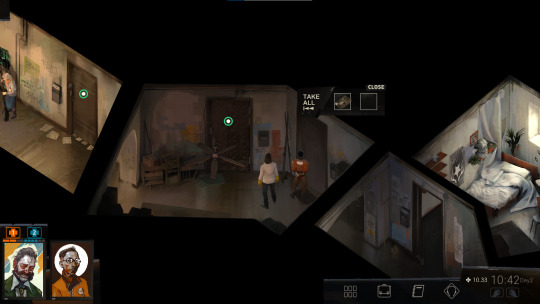
There's a postcard in this box.

POSTCARD "BOOGIE STREET '46"
This crumpled up postcard depicts an open air market in Boogie Street -- 5 years ago. A vendor smiles as dead roosters line his stalls -- hung by their feet from canopy. Red blood flows onto the muddy street, blurry shadows of people pass.
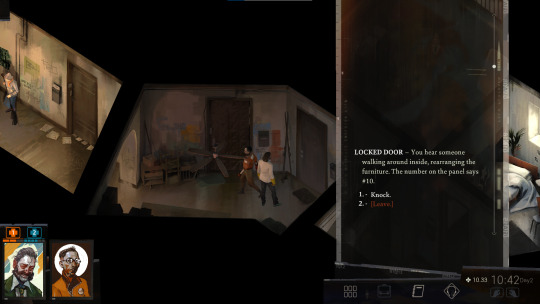
LOCKED DOOR - You hear someone walking around inside, rearranging the furniture. The number on the panel says #10.
Knock.
[Leave.]
LOCKED DOOR - The walking stops abruptly, but no one comes to the door.
INLAND EMPIRE [Medium: Success] - You can feel tension on the other side.
Knock again.
LOCKED DOOR - This time the steps come closer. "Who is this?" demands a female voice, wary and tense.
"This is the police. Open up."
LOCKED DOOR - "Do I *have to* open the door?" You hear the clacking of heels again, as the other side walks right up to the door. Her tone is now getting a defensive edge...
"Do you have a warrant? I'm not obligated to open the door if you don't have a warrant."
KIM KITSURAGI - "Let's go," the lieutenant says, "we don't have a reason to get inside that apartment."
2. [Leave.]

The door #9 is locked.
There's also 0.25 real in a box here.
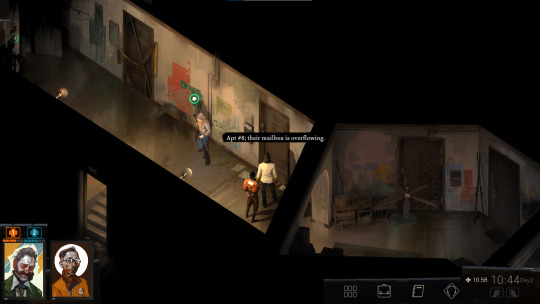
Apt #8, their mailbox is overflowing.

The graffito says: "A firing squad for the rich."

A note reads "Foreclosed by Martinaise Realty Associates."

CLEANING LADY - "Give me a moment." An elderly woman is leaning on her broom, her knuckles white as bone. She seems to be having difficulty breathing.
"The cold never does any good for my bronchitis..." She sneezes into a dirty handkerchief.
"Are you alright? Should I call a doctor?"
"This won't take long, I only have a few questions."
Let's do it later... [Leave.]
CLEANING LADY - "I'm fine, fine, don't you worry about me!" She starts coughing, red spots appearing on her cheeks.
EMPATHY [Medium: Success] - You're still worried. It's very worrying.
CLEANING LADY - "Now, what do you want from me, policeman?"
"Who are you?"
"I am looking for Martin Martinaise."
"I have a few questions about those apartments..."
"Thanks, I'm off." [Leave.]
CLEANING LADY - "I'm no one, just an old woman who cleans these hallways."
"Do you live here?"
CLEANING LADY - "If you can call it living..." She spits on the floor, before wiping it off with a broom. "I have a little room upstairs, right next to the coal room."
"It's barely bigger than a closet, but I don't complain, no…" She juts out her chin, eyes shining. "I have my bed and my aching bones to keep me company and that's all I need from this world."
2. "I am looking for Martin Martinaise."
CLEANING LADY - "Oh, you'll find plenty of Martins here, don't you worry!" She smiles a gap toothed smile when she hears you mention the name.
"What do you mean? I wasn't joking."
"No, you don't understand. I'm looking for a real person named Martin Martinaise. He told me he's Martin Martinaise."
CLEANING LADY - "Pea-brain, someone played a trick on you. Martin Martinaise is a name for *anyone* from Martinaise. Like Jim Jamrock or Raoul Revachol."
+5 XP
RHETORIC [Medium: Failure] - Oops... you really didn't get the joke there.
KIM KITSURAGI - "I thought it was obvious..." He stops before he offends you. "Anyway, officer. We *don't* have the witness' name."
2. "How about a young male in his mid-twenties, dark hair, skinny build? A smoker on the balcony. Know where he lives?"
CLEANING LADY - "Yes-yes. I know who you mean. The scrawny boy who's always smoking like the devil, right?" She looks at the other end of the hallway.
"What's he in trouble for?"
12 notes
·
View notes
Text
Article from The Conversation on our Chicano Park research.
Urban wellbeing is increasingly tied to what urban planners term “green” and “blue” spaces: the parks and waterfronts that our towns and cities may include. Residents are also encouraged to leave the city altogether, to seek out the healthy calm of forest bathing, fell running or cold water swimming.
The potential of play within the urban environment, however, is often overlooked.
Skateboarders have long been invested in what I call “grey” space: the overlooked corners, edges and surfaces of the built environment. Skateboard magazines and videos routinely explore the social and architectural histories of sets of stairs and stone benches.
These spots, largely invisible to the general public, are richly symbolic. In seeing them as ramps and launchpads, skaters transform unremarkable bits of the city into ritual places of magic and wonder.
Recent research conducted with my colleague, Andrea Buchetti, shows that skateparks are sites of unstructured play and community, as well as remembrance and ritual. Otherwise banal and polluted locations are afforded layers of meaning and depth.
Skatepark memorialisation
The Chicano Park skatepark in San Diego is nestled below the imposing, blocky concrete columns of the on-ramps for the city’s Coronado bridge.
Built in 2015, the skatepark features four vibrant murals (by artists including Ricardo Islas) that draw on both the indigenous heritage of this ancient northern Mexican region and skateboard iconography. In memory of lost friends, local skateboarders build shrines at the foot of the paintings using broken skateboards, rocks, cacti and cut flowers.
The five-lane highway bridge above it stands 61 metres tall, allowing safe passage for ships bound to the nearby naval base. Completed in 1969, it links downtown San Diego with the smaller city of Coronado across San Diego Bay.
The space beneath the bridge has long been contested. When built, its route divided a longstanding Mexican American neighbourhood, Barrio Logan, that had already been disrupted by the construction of the Interstate 5 in 1963. Over 5,000 homes and businesses were destroyed in the process.
The state had promised the community a park by way of compensation. But on April 22 1970, Mario Solis, a local student, noticed bulldozers where the park should be, and found out the city was, in fact, constructing a highway patrol base there.
At Solis’s urging, more than 250 residents gathered with shovels and pickaxes to reclaim the land. They planted cacti and trees to create a communal park. After three months of protest, the city conceded to work with the community, and Chicano Park was officially established.
Local artist Salvador Torres was one of the people who lost their homes. In 1973, he galvanised the community into painting murals on the imposing chunks of concrete built in their stead. It was a form of creative resistance. The motifs referenced the cultural heritage of this ancient northern Mexican region, from Aztec symbolism to indigenous plants and beasts, and also Mexico’s colonial experience and revolutionary struggles.
The park is now a protected historic space and landmark. People gather there for annual celebrations on April 22.
Skateboarding as culture and community
Research has long shown the connection between sport and religion. Fans make pilgrimages to stadiums and worship athletes like gods.
Just as a football fan might worship at Wembley stadium in London, a specific neighbourhood curb might hold great significance because of a connection to a famous skater or a historic event. I have shown how skateboarding functions as a lifestyle religion. In the way they observe, perform and organise their communal activity, skateboarders derive spiritual expression and identity from both the physical act of skateboarding and the places in which it is conducted.
Some skateparks have dedicated plaques and permanent memorials designed into skateable features. When legendary San Francisco skateboarder and chief-editor of Thrasher magazine, Jake Phelps, died in 2019, a sculptor in Los Angeles made a concrete tombstone feature to install in the Lower Bob’s DIY skatepark in Oakland. He mixed some used dental floss Phelps had left behind into the concrete. “We don’t got his cremated body,” the artist told Thrasher, “but we got pretty much all the DNA we’re gonna need.”
London’s Skateboard Graveyard on one of the supports of Hungerford Bridge, on the South Bank, is another salient example. For years now, old boards have been thrown down from the Golden Jubilee footbridge in memory of Timothy Baxter, one of two skaters who were attacked and thrown into the river Thames in 1999.
Baxter died as a result and the juvenile attackers were convicted of manslaughter. Many of the skateboarders who take part in the ritual might not know that this is how it began, yet they persist in offering their broken boards to the site.
RIP epitaphs
In 2023, the skatepark in Sacramento’s Regency Park was renamed in honour of Tyre Nichols, a skateboarder who was beaten to death by police officers in Memphis, Tennessee.
Australian graphic design expert Dan Johnston has identified RIP epitaphs as one of the most common types of skateboarding-related graffiti. He cites messages he has noted on the steel ramps and concrete bumps of skater desinations in Singapore, Paris and south Australia – RIPs and Miss Us scrawled in white correction fluid, marker pen or spray paint.
Despite skateboarding’s recent ascent to Olympic status, for many skateboarders it is more a culture – or even a cult – than a sport. It brings diverse people together for unsanctioned play, recasting obstacles – an impassable buckled road in Wiltshire, say – as toys and tools.
In their provocative curves and surfaces, skateparks embody this creativity. They mimic the city beyond, showing how the built environment cannot just be conceived of as a framework for economic activity. Grey space – and grey times – can be transformed if communities, and the DIY cultures they give birth to, are allowed to flourish in the city.
2 notes
·
View notes
Text
The penetration of China by Buddhism not only gave the Chinese a new religion but, of central importance to this narrative, it gave to the world an entirely new style of art which has come to be known as Serindian. This term is coined from the two words Seres (China) and India. Logically it should have been simply a fusion of Indian Buddhist art and the art of contemporary Han China. It almost certainly would have been had it not been for the great Himalayan massif which so effectively isolated China from all direct contact with India. But faced by this impenetrable barrier, the gospel of Buddhism together with its art came to China by a roundabout route, gradually absorbing other influences on its way. Its real point of departure was not India proper but the Buddhist kingdom of Gandhara, situated in the Peshawar valley region of what is now north-western Pakistan. Here another artistic marriage had already taken place. This was between Indian Buddhist art, imported by the ruling Kushans (descendants of the Yueh-chih) in the first century AD, and Greek art, introduced to the region four hundred years earlier by Alexander the Great.
The most revolutionary product of this Graeco-Buddhist, or Gandharan, school was the depiction of Buddha in human form, for it was the first time that artists anywhere had allowed themselves to show him thus. As a being who had ceased to exist, theologically speaking, by achieving Nirvana and thus escaping the endless cycle of rebirth, he had always been portrayed before by means of a mystical symbol such as a single footprint, a wheel, a tree, a stupa or Sanskrit characters. But the Gandharan Buddha is shown by sculptors with straight, sharply chiselled nose and brow, classical lips and wavy hair–all Hellenistic influences. Another obvious Mediterranean introduction is the diaphanous, toga-like robe he wears in place of the expected loin cloth. But his eyes are heavy-lidded and protruding, the lobes of the ears elongated, and the oval-shaped face fleshy–all characteristics of Indian iconography. The stretched ear lobes symbolise Buddha’s casting away of the heavy, jewelled and worldly earrings that he had worn as a wealthy prince before his conversion to a life of self-denial and teaching
—Peter Hopkirk, Foreign Devils on the Silk Road: The Search for the Lost Cities and Treasures of Chinese Central Asia
#peter hopkirk#foreign devils on the silk road#history#china#india#gandhara#Buddhism#art#w#2024 reads#upl#reading through the silk road
2 notes
·
View notes
Text
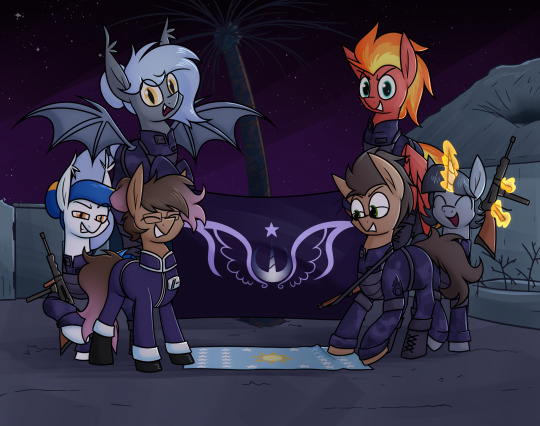
Marfilita reclaimed! The Empire takes yet another step to restoring justice, order, and progress to the island of Puerto Caballo! A great victory has been achieved!
As the might of the Lunar Empire grew and as more of its enemies were crushed beneath its hooves, the Equestrian Provisional Government in Puerto Caballo remained a thorn in its side.
It was bad enough for the Empire that Puerto Caballo was protected by the fleet of the Kingdom of Aquileia, it was even worse when Aquileian and Arisian forces were providing training and supplies to the Puerto Caballans, and made downright humiliating as Arisian intelligence were transporting Puerto Caballan operatives around the world to strike at Lunar power wherever it sought to impose itself.
Yet this would not last. Quietly, the Lunar Empire had a sophisticated plan of its own to reclaim the islands. Through extensive reconnaissance and planning, an invasion force capable of seizing the islands within months was constructed and put into place. The threat of Aquileian intervention was thwarted as the Empire supported the growing revolutionary republican movement in Aquileia itself by providing funds and intelligence to its organisers and giving them shelter in New Mareland. This culminated in the 2 January overthrow of the Kingdom of Aquileia in a coup/uprising by the local republicans, and a new democratic pro-Lunar government was established. At last, the way was clear.
Operation Hurricane was launched on 11 January, the initial landings involving 120,000 soldiers and the overall operation involving nearly 400,000 troops with support from dozens of ships, thousands of aircraft and tanks, and the Empire's most elite combat mages. The defenders, even with all their weapons and training, didn't stand a chance. Just three nights into the invasion, the symbolic village of Marfiltia was taken by Lunar marines. To celebrate their victory, several of the marines involved in the attack had a picture taken of them posing with the Imperial flag over a Loyalist flag, mimicking a famous piece of Loyalist iconography (seen here).
Victory was declared on 26 March with the total collapse of the EPG. Thousands of Loyalists were killed, many more were captured, and those who avoided capture had been scattered to the wind. Or so the Empire thought.
Even though the EPG itself has fallen, resistance remained strong. Deep in the jungles and high in the mountains, a guerrilla insurgency raged on in defiance of the Lunar occupiers. The question was then a matter of who would break first, the vengeful Empire with all its terrifying might or the tenacious rebels with nothing to lose but each other?
https://derpibooru.org/images/3136802
7 notes
·
View notes
Note
I was today years old when I found out that Johnny Marr played guitar on & CO-WROTE Billy Bragg's Sexuality & it has sent my Marrissey brain into overdrive 👀
ooh yes! Johnny in his autobio talked about how he one day heard Billy Bragg fiddling in his studio with this idea of a song with "some interesting phrases about sexuality" so Johnny took the tape home and perfected the track and from it sprang Sexuality, a "great pop song with brilliant lyrics", as he put it
And just because you're gay I won't turn you away
If you stick around I'm sure that we can find some common ground
i know nowadays this seems like basic humanity but at the time, at the height of the AIDS epidemic that disproportionately affected the gay community, it must have been revolutionary, a real show of support
unfortunately, over the years, Billy Bragg has taken to changing the line "sexuality, don't threaten me with misery" to "sexuality, don't threaten me with Morrissey", so sometimes allyship does go out the window, huh
Johnny has always presented himself as an ally, and very genuinely at that. whether there was a hint of curiosity or personal experience is up for speculation. Johnny has never neglected to mention growing up immersed in the feminine ethos and "around loads of gay boys" (he goes on to say that but i'm linking the start of his thought). Morrissey recounted having the same upbringing. Johnny then continues in his talk saying how Manchester had then and still does now a "thriving, absolutely vibrant, very important gay scene" and how the best time you could have was in the gay clubs, where, incidentally, the Smiths played some of their first gigs, according to Johnny's autiobio. back to the video [ON WHICH JOHNNY DOES NOT GET QUOTED ENOUGH and maybe i should and will do], "in the very, very early days, when it probably was just even me and Morrissey, we had to almost reign it in, we had to maybe take a step back and be a bit more palatable. we would've probably been a much more radical band… but look at our first single [Hand in Glove], the first single cover, it's one of the things i'm very, very proud of and Morrissey's contribution which was the iconography".
since i've already brought up Johnny's talk at the Oxford Union in 2019, and he's absolutely brilliant in it - he's asked maybe a handful of questions but he builds so well on them - i will hijack your ask to highlight some of my favourite moments from it
right off the bat, 7:08 "i'm not famous for extremely controversial statements AHEM" fuck you johnny, you petty child. barely lasted 7 minutes without getting a laugh at Morrissey's expense but then he COMPLETELY loses his train of thought for a good 20 seconds. he needs to recalibrate after that Morrissey mention because god knows where his minds goes veering off to. totally self-inflicted and absolutely deserved
…
"that might sound a little pretentious or highfalutin, and so what, i'm pretentious" this was just funny and the very thing you'd expect the man Morrissey fell in love with to say
…
the same Johnny who never fails to talk about the Love between him and Morrissey (18:11) "i went and knocked on Morrissey's door and put this band together. strangers, you learn to love each other… very quickly."
27:49 just Johnny being funny saying he never wanted to look at the same bass player for 40 years, then catches himself to say he still does, with him and Andy being mates, corrects it to never wanted to look at the same drummer for 30 years, for 10 years (when i tell you i waited with bated breath for him to say singer but he didn't), then he says "that's not personal, i just saw my future differently". then, i think he gets a little emotional, saying it was "sad how it came out", having to break off from the Smiths to realize the vision of his music career he had from the start
34:21 that question was bait but i think Johnny subverts the expectation that he's going to dump on Morrissey for his lyrical contribution to Some Girls… and instead he says he loved it, it was great when he'd get unexpected lyrics to go with his music. i love Johnny's analogy of a painting of a camel against the backdrop of the British coastline but that in fairness, he couldn't think "of a Smiths song that sounded like a camel". he becomes so lovely, so loving when he talks about the recording/producing process of Smiths songs, how unorthodox they were, he gets transformed. "the probably boring answer that at that time, Morrissey was my best mate and we loved everything that each other did and we both thought everything we did was brilliant"
46:10 "i didn't want to do any Smiths songs for years and years because 1. i just felt like no one should and 2. i was fucked up about it and now i learned not to be fucked up about it and to be alright with your past" he calls There is a Light… a perfect marriage of poetry and music
48:05-48:20 DESERVED A LAUGH, stupid audience
49:05 on the endurance of the Smiths songs, "because there's loads of emotion in the recording, almost every single Smiths song, because even if it's just from me - i can't speak for the other fellas - because when we were recording it, i felt like i was three feet off the ground. because i loved what i was playing, loved the situation i was in and i loved my life, and it was this unbelievable high that was imbued and infused in the recordings"
i'm sorry if this was more than you or anybody bargained for but again, i would recommend listening to an hour of Johnny talking any day
p.s. on the one hand, i understand Morrissey's open letter, he got tired of being a talking point or comedic fodder. on the other hand, Johnny was still talking about what they had with so much love, even in 2019
11 notes
·
View notes
Text




New Title Tuesday: History Recommendations
Ancient Africa by Christopher Ehret
This book brings together archaeological and linguistic evidence to provide a sweeping global history of ancient Africa, tracing how the continent played an important role in the technological, agricultural, and economic transitions of world civilization. Christopher Ehret takes readers from the close of the last Ice Age some ten thousand years ago, when a changing climate allowed for the transition from hunting and gathering to the cultivation of crops and raising of livestock, to the rise of kingdoms and empires in the first centuries of the common era.
Ehret takes up the problem of how we discuss Africa in the context of global history, combining results of multiple disciplines. He sheds light on the rich history of technological innovation by African societies - from advances in ceramics to cotton weaving and iron smelting - highlighting the important contributions of women as inventors and innovators. He shows how Africa helped to usher in an age of agricultural exchange, exporting essential crops as well as new agricultural methods into other regions, and how African traders and merchants led a commercial revolution spanning diverse regions and cultures. Ehret lays out the deeply African foundations of ancient Egyptian culture, beliefs, and institutions and discusses early Christianity in Africa.
Anne Boleyn & Elizabeth I by Tracy Borman
Anne Boleyn is a subject of enduring fascination. By far the most famous of Henry VIII's six wives, she has inspired books, documentaries and films, and is the subject of intense debate even today, almost 500 years after her violent death. For the most part, she is considered in the context of her relationship with Tudor England's much-married monarch. Dramatic though this story is, of even greater interest - and significance - is the relationship between Anne and her daughter, the future Elizabeth I. Elizabeth was less than three years old when her mother was executed. Given that she could have held precious few memories of Anne, it is often assumed that her mother exerted little influence over her.
Nothing could be further from the truth.
Piecing together evidence from original documents and artefacts, this book tells the fascinating, often surprising story of Anne Boleyn's relationship with, and influence over her daughter Elizabeth. In so doing, it sheds new light on two of the most famous women in history and how they changed England forever.
Symbols of Freedom by Matthew J. Clavin
In the early United States, anthems, flags, holidays, monuments, and memorials were powerful symbols of an American identity that helped unify a divided people. A language of freedom played a similar role in shaping the new nation. The Declaration of Independence’s assertion “that all men are created equal,” Patrick Henry’s cry of “Give me liberty, or give me death!,” and Francis Scott Key’s “star-spangled banner” waving over “the land of the free and the home of the brave,” were anthemic celebrations of a newly free people. Resonating across the country, they encouraged the creation of a republic where the right to “life, liberty, and the pursuit of happiness” was universal, natural, and inalienable.
For enslaved people and their allies, the language and symbols that served as national touchstones made a mockery of freedom. Deriding the ideas that infused the republic’s founding, they encouraged an empty American culture that accepted the abstract notion of equality rather than the concrete idea. Yet, as award-winning author Matthew J. Clavin reveals, it was these powerful expressions of American nationalism that inspired forceful and even violent resistance to slavery.
Symbols of Freedom is the surprising story of how enslaved people and their allies drew inspiration from the language and symbols of American freedom. Interpreting patriotic words, phrases, and iconography literally, they embraced a revolutionary nationalism that not only justified but generated open opposition. Mindful and proud that theirs was a nation born in blood, these disparate patriots fought to fulfill the republic’s promise by waging war against slavery.
In a time when the US flag, the Fourth of July, and historical sites have never been more contested, this book reminds us that symbols are living artifacts whose power is derived from the meaning with which we imbue them.
The Ruble by Ekaterina Pravilova
Money seems passive, a silent witness to the deeds and misdeeds of its holders, but through its history intimate dramas and grand historical processes can be told. So argues this sweeping narrative of the ruble's story from the time of Catherine the Great to Lenin.
The Russian ruble did not enjoy a particularly reputable place among European currencies. Across two hundred years, long periods of financial turmoil were followed by energetic and pragmatic reforms that invariably ended with another collapse. Why did a country with an industrializing economy, solid private property rights, and (until 1918) a near perfect reputation as a rock-solid repayer of its debts stick for such a prolonged period with an inconvertible currency? Why did the Russian gold standard differ from the European model
In answering these questions, Ekaterina Pravilova argues that politics and culture must be considered alongside economic factors. The history of the Russian ruble offers an opportunity to explore the political reasons behind the preservation of a supposedly backward financial system and to show how politicians used monetary reforms to block or enact political transformations.
#history#nonfiction books#nonfiction#new books#reading recommendations#reading recs#book recommendations#book recs#library books#tbr#tbrpile#to read#booklr#book tumblr#book blog#library blog#readers advisory
2 notes
·
View notes